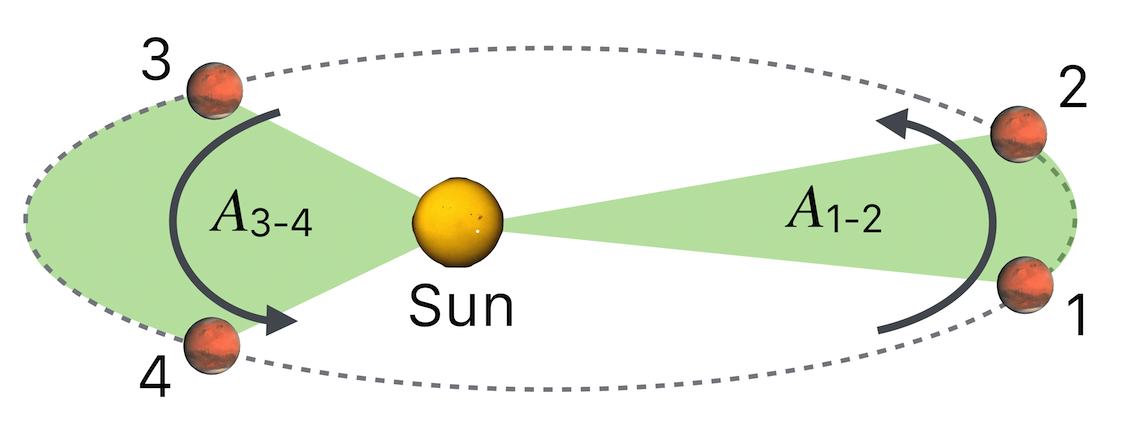9.7. Kepler’s Battle With Mars#
When Kepler went to work for Tycho in Prague it turned out to not be a marriage made in heaven. Kepler inherited Tycho’s job as Imperial Mathematician and a long headache of law suits. Tycho was possessive of his data and Kepler wanted desperately to get his hands on it and was frustrated at it being fed to him piecemeal. He was determined to solve “the Mars problem,” namely the retrograde motion problem and Tycho’s decades of precise Mars data was just out of his grasp. However, Tycho’s mishap at the banquet left Kepler with an opportunity, which he took. Or rather, he took the data, only to be hounded by Tycho’s heirs for nearly the rest of his life. In a legal decision, he agreed to publish Tycho’s data in a book dedicated to the Emperor and the Rudolphine Tables were eventually published, but not until Kepler had thoroughly analyzed the data. He won the battle of Mars.
Pens out!
Remember that circles were an unquestioned feature of all of astronomy for two millennia. What Kepler found was that the orbit of Mars would just not fit a circular path. After anguishing over this, in heroic calculations, he determined that the orbit was elliptical with the Sun, not at the center of the ellipse, but at one of the foci. This was an intellectually brave conclusion given the dominance of the circular prejudice. In 1609 he published these ellipse results (Kepler’s First law) in Astronomia nova (New Astronomy) along with his discovery that the planets sweep out equal areas in equal times as their speeds change as the approach and move away from the Sun (Kepler’s Second Law, but it actually came first). Notice in the figure that the area A is equal to area B, so that the planet is going faster close to the sun.

The planetary orbits are in the shapes of ellipses.
Later in 1619 he published an extension of his cosmology in Harmonices mundi libri, Harmonies of the World. Plato’s solids were still there as was a considerable amount of new mathematics, and his Third Law: for any two planets the ratio of the squares of their periods[^7] is proportional to the ratio of the cubes of their average distance from center of their orbits. Said in symbols, where \(T\) is the period and \(R\) is the mean orbit radius:
Pens out!
This can be turned around into an equation by creating a constant of proportionality, \(k_S\), for “sun.” Then:
Using modern numbers for a few of the planets:
planet period (s) average distance (m) \(k_S\)
earth \(3.156 \times 10^7\) \(1.4957 \times 10^{11}\) \(2.977 \times 10^{-19}\) mars \(5.93 \times 10^7\) \(2.278 \times 10^{11}\) \(2.975 \times 10^{-19}\) saturn \(9.27 \times 10^8\) \(1.427 \times 10^{12}\) \(2.957 \times 10^{-19}\)
Table: (#tab:keplerslaw) The first three planets and the ratio of \({T^2}/{R^3}\).
Notice that they all have the same value for \({T^2}/{R^3}\), what I’ve called \(k_S\). This agreement is universal for all of the planets…and as we’ll see, any “Copernican-like” system. Such as the moon-earth? Stay tuned.
All told, he proposed 3 rules, which of course are called Kepler’s laws:
The law of Orbits: All planets move in elliptical orbits with the sun at one focus.
The law of Areas: A line that connects a planet to the sun sweeps out equal areas in equal times. You can see this in the figure above. Notice that this requires that when a planet is near the sun it’s moving faster than when it is away from the sun.
The law of Periods: The square of the period of any planet is proportional to the cube of the semimajor axis of its orbit. This is written just above in a simple proportionality. The planets are truly elliptical, but not very much so that \(R\) can be treated as the average radius of the orbit with little error.
Kepler was quite amazing. While considerably under pressure of family and health he came close to inventing calculus (in trying to calculate the volume of wine casks), conceiving of gravitational attraction as the source of planetary binding (he was familiar with the work of Walter Gilbert in England who determined that the Earth was a large magnet and imagined the Sun as emanating a magnetic attraction to the planets), optical telescopes (he worked out the correct geometrical optics of concave and convex lenses after Galileo’s publications), and fiction (as I mentioned, he wrote the first science fiction novel).
You might benefit from 7.2_cosmology3_kepler_v3.mp4 for review and wrap-up of these sections.
Kepler is one of my personal scientific heroes. He, before anyone, was intellectually brave enough to abandon circles as the path of the planets. He followed the data, rather than authority.
In some ways, he straddles the Renaissance and the birth of modern physics and astronomy. So in the next chapter we’ll take the leap into the Scientific Revolution with Galileo’s telescope and Newton’s enormous intellect.
Please answer Question 6 for points:
Please answer Question 7 for points:
Please answer Question 8 for points:
Please answer Question 9 for points:
Please answer Question 10 for points: